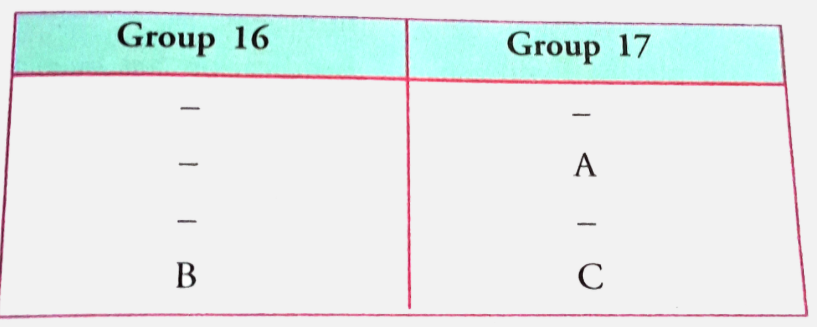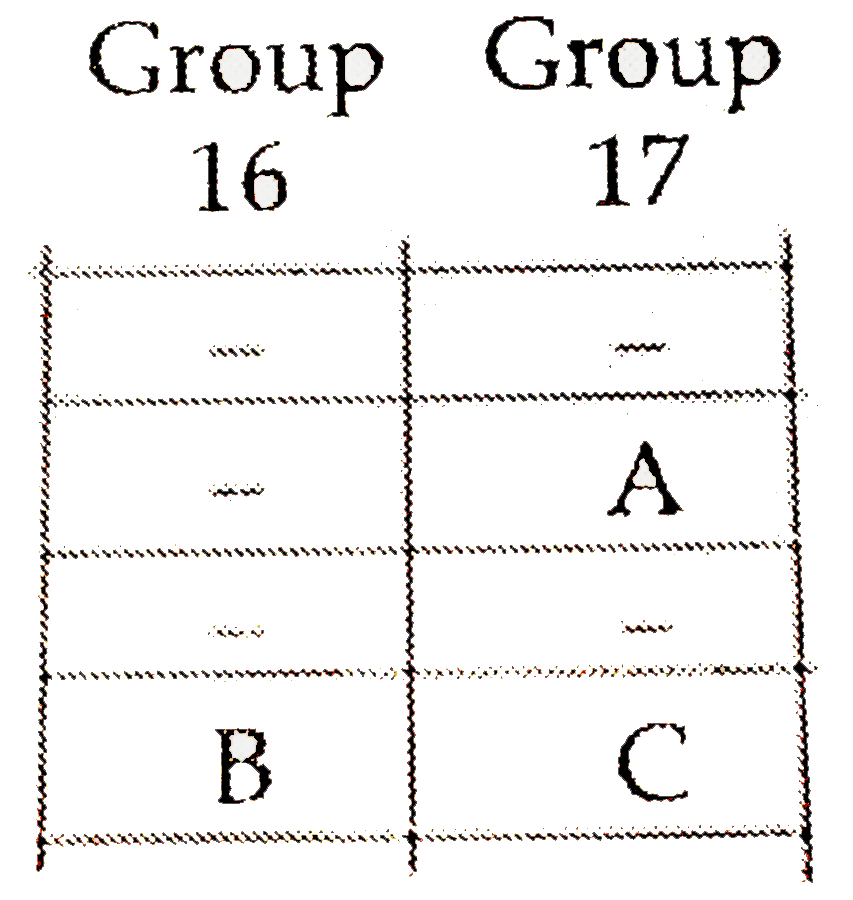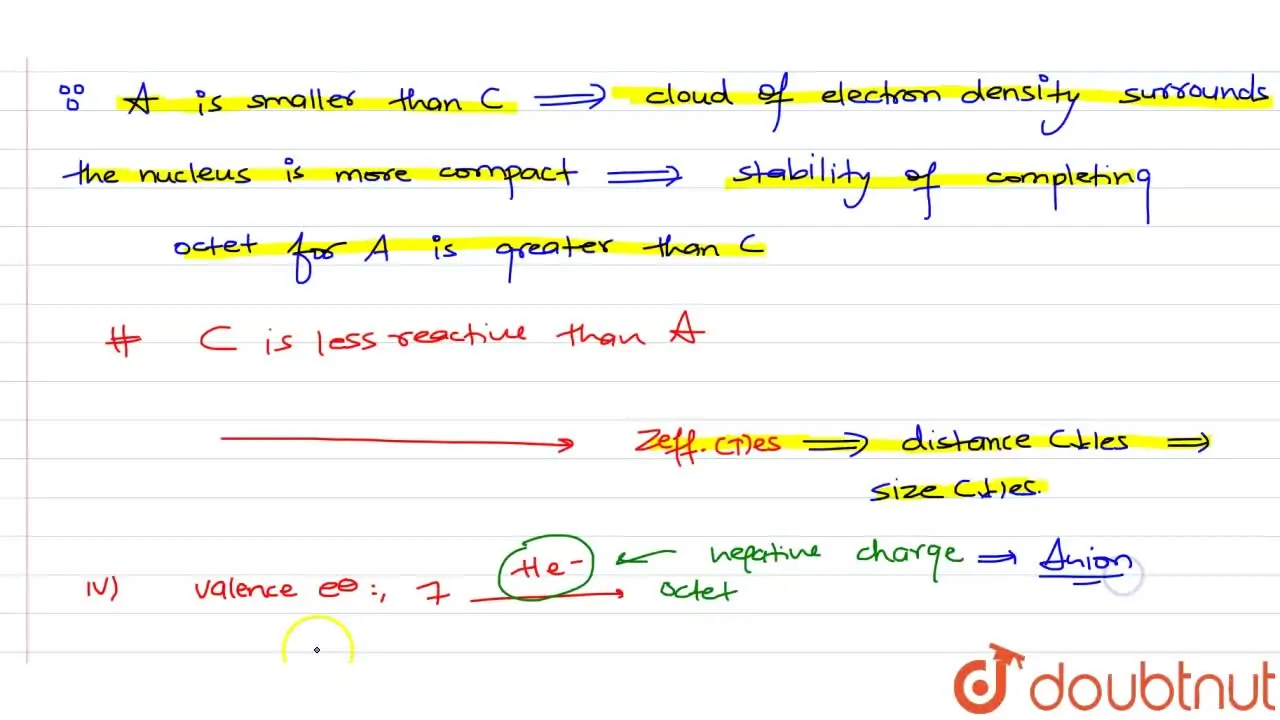The position of three elements A, B and C in the Periodic Table are shown below:

(a) State whether A is a metal or a non-metal.
(b) State whether C is more reactive or less reactive than A.
(c) Will C be larger or smaller in size than B?
(d) Which type of ion-cation or anion will be formed by element A?
(a) Metals lie on the left-hand side of the Periodic Table whereas non-metals are found on the right-hand side. The element A is in group 17. Group 17 is on the right side of the Periodic Table. Thus, element A is a non-metal (called halogen).
(b) The chemical reactivity of non-metals decreases on going down in a group. In group 17, the chemical reactivity decreases on going down in a group. So, element C is less reactive than A.
(c) The atomic size decreases in moving from left to right along a period. So, atom C will be smaller in size than B.
(d) The element A of group 17 has 7 valence electrons. So, it will gain one electron to form a negatively charged ion . The negatively charged ion is called an anion. So, element A will form an anion.
Related Playlists
- BOOK - VK GLOBAL PUBLICATIONCHAPTER - PERIODIC CLASSIFICATION OF ELEMENTS EXERCISE - VERY SHORT ANSWER QUESTIONS14videos
PERIODIC CLASSIFICATION OF ELEMENTS
- BOOK - VK GLOBAL PUBLICATIONCHAPTER - PERIODIC CLASSIFICATION OF ELEMENTS EXERCISE - SHORT ANSWER QUESTIONS-I23videos
PERIODIC CLASSIFICATION OF ELEMENTS
- BOOK - VK GLOBAL PUBLICATIONCHAPTER - PERIODIC CLASSIFICATION OF ELEMENTS EXERCISE - PROFICIENCY EXERCISE (LONG ANSWER QUESTIONS)3videos
PERIODIC CLASSIFICATION OF ELEMENTS
- BOOK - VK GLOBAL PUBLICATIONCHAPTER - MODEL QUESTIONS PAPER - 5EXERCISE - SECTION B3videos
MODEL QUESTIONS PAPER - 5
- BOOK - VK GLOBAL PUBLICATIONCHAPTER - PRACTICAL BASED QUESTIONSEXERCISE - Experiment 154videos
PRACTICAL BASED QUESTIONS
Similar Questions
The position of three elements A, B and C in che periodic table are shown below :

(a) State whether A is metal or non-metal.
(b) Seate whether C is more reactive or less reactive than A.
(c) Will C be larger or smaller in size than B ?
(d) Which type of ion, cation or anion will be formed by the element A ?View SolutionThe positions of three elements A,B and C in the periodic table are shown here
(a) State whether A is a metal or non-metal?

State whether C is more reactive or less reactive than A
(c) Will C be larger or smaller in size than B?
(d) Which type of ion, cation or anion, will be formed by element A?View SolutionThe position of three elements A, B and C in the Periodic Table are shown below :
Group 16Group 17−−−A−−BC
(a) State whether A is a metal or non-metal.
(b) State whether C is more reactive or less reactive than A.
(c) Will C be larger or smaller in size than B?
(d) Which type of ion, cation or anion, will be formed by element A ?View SolutionThe position of three elements A, B and C in the Periodic Table are shown below –
Group16Group17−−−A−−BC
(a) State whether A is a metal or non-metal.
(b) State whether C is more reactive or less reactive than A.
(c) Will C be larger or smaller in size than B?
(d) Which type of ion, cation or anion, will be formed by element A?View SolutionThe position of three elements A, B and C in the Periodic table are shown below :

Will C be larger or smaller in size than B?View SolutionThe positions of three elements P, Q and R in the periodic table are shown below

Which of these three elements is most non-metallic ?View SolutionThe positions of three elements A, B and C in the periodic table are shown below:
Group 16Group 17−−−A−−BC
State whether C is more reactive or less reactive than A.View SolutionThe positions of three elements A, B and C in the periodic table are shown below:
Group 16Group 17−−−A−−BC
State whether A is metal or non-metal.View SolutionThe position of three elements A, B and C in the Periodic table are shown below :

Which type of ion, cation or anion, will be formed by element A?View SolutionThe positions of four elements A, B, C and D in the Modern Periodic Table are shown below. Which element is most likely to form an acidic oxide ?
 View Solution
View Solution


